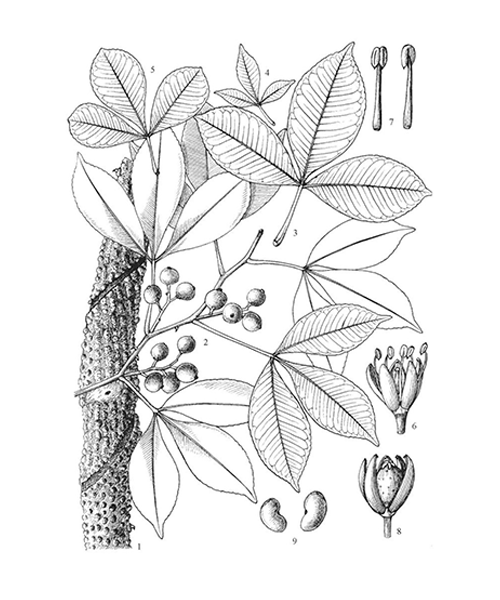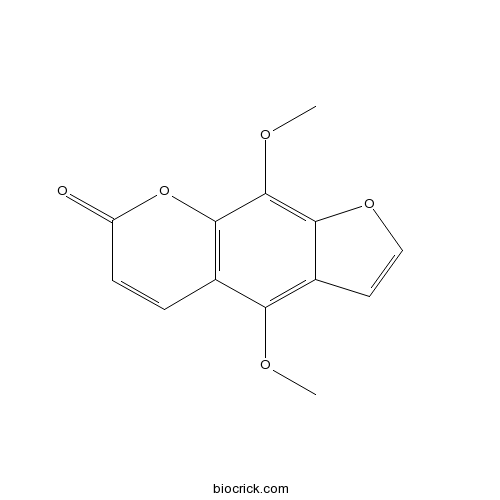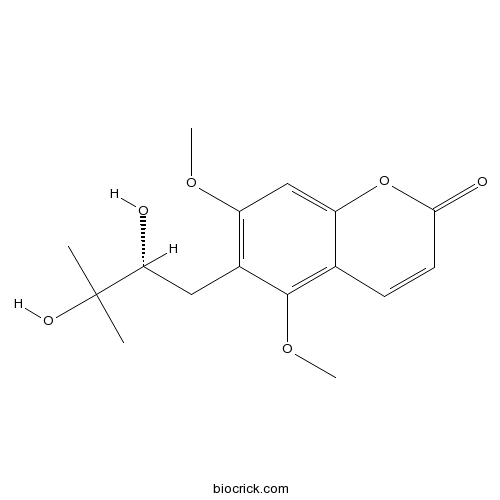Toddalia asiatica
Toddalia asiatica
1. The products in our compound library are selected from thousands of unique natural products; 2. It has the characteristics of diverse structure, diverse sources and wide coverage of activities; 3. Provide information on the activity of products from major journals, patents and research reports around the world, providing theoretical direction and research basis for further research and screening; 4. Free combination according to the type, source, target and disease of natural product; 5. The compound powder is placed in a covered tube and then discharged into a 10 x 10 cryostat; 6. Transport in ice pack or dry ice pack. Please store it at -20 °C as soon as possible after receiving the product, and use it as soon as possible after opening.

Natural products/compounds from Toddalia asiatica
- Cat.No. Product Name CAS Number COA
-
BCN6165
Protopine130-86-9
Instructions

-
BCN4957
Nitidine chloride13063-04-2
Instructions

-
BCN6168
Pimpinellin131-12-4
Instructions

-
BCN5915
Neohesperidin13241-33-3
Instructions

-
BCN2637
Phellopterin2543-94-4
Instructions

-
BCN5568
Isopimpinellin482-27-9
Instructions

-
BCN2393
Toddalolactone483-90-9
Instructions

-
BCN1273
Dictamnine484-29-7
Instructions

-
BCN4187
Shanzhiside methylester64421-28-9
Instructions

-
BCN6309
Coumarin91-64-5
Instructions

Evaluation of Aculeatin and Toddaculin Isolated from Toddalia asiatica as Anti-inflammatory Agents in LPS-Stimulated RAW264 Macrophages.[Pubmed: 29311475]
Anti-inflammatory activity of aculeatin and toddaculin, which are coumarins with a similar structure isolated from Toddalia asiatica (L.) LAM., was evaluated using lipopolysaccharide (LPS)-stimulated RAW264 mouse macrophage cells. Both aculeatin and toddaculin significantly inhibited mRNA expression of inflammatory mediators and nitric oxide production. Furthermore, Toddaculin suppressed LPS-induced phosphorylation of p38 and extracellular signal-regulated kinase (ERK)1/2 and inhibited LPS-induced activation of nuclear factor-kappaB (NF-κB). However, aculeatin did not exhibit such effects, suggesting that aculeatin and toddaculin suppress LPS-induced inflammation of RAW264 cells via different mechanisms. The cellular uptake of these compounds was also evaluated. Toddaculin was detected in RAW264 cells after 4 and 24 h. However, aculeatin levels were not observed in RAW264 cells at all incubation intervals. These results indicate that de-epoxidation of a prenyl group can increase hydrophobicity of molecule and is thought to accelerate cellular uptake and/or interactions with the phospholipid bilayers of cell membranes.
Chelerythrine Inhibits Human Hepatocellular Carcinoma Metastasis in Vitro.[Pubmed: 29093327]
Chelerythrine (CHE) is a type of benzophenanthridine alkaloid found in many herbs and is also the main alkaloid constituent of Toddalia asiatica (L.) LAM. It has been proven to have various activities including antitumor, antifungal, anti-inflammatory and anti-parasitic effects. We have previously demonstrated that CHE can inhibit proliferation and promote apoptosis in human hepatocellular carcinoma (HCC) cells. However, the effect of CHE on the metastasis of HCC and its related molecular mechanisms have yet to be validated. In this study, we investigated the effects of CHE on the migration and invasion of the HCC cell line Hep3B. 3-(4,5-Dimethylthiazol-2-yl)-2,5-diphenyltetrazolium bromide (MTT), wounding healing, transwell migration and invasion assays and cytoskeleton staining demonstrated that CHE could inhibit the migration and invasion of Hep3B cells in a dose-dependent manner with change of cell structure. RNA interference studies made a knockdown of matrix metalloproteinase (MMP)-2/9 respectively in Hep3B cells. And the results of wounding healing and transwell invasion assay with the treatment of small interfering RNA (siRNA) investigated that MMP-2/9 are positively associated with Hep3B cell metastasis. The results of enzyme-linked immunosorbent assay (ELISA), Western blotting and quantitative RT-PCR showed that CHE suppressed the expression of MMP-2/9 at both mRNA and protein levels. CHE also exhibited an inhibitory effect on the phosphorylation of Focal adhesion kinase (FAK), phosphatidylinositol 3-kinase (PI3K), Akt, mammalian target of rapamycin (mTOR), c-Jun N-terminal kinase (JNK), extracellular signal-regulated kinases (ERK) and p38. In summary, on Hep3B cells, CHE could change the cell cytoskeletal structures through reducing the expression of p-FAK and inhibit the metastasis of Hep3B cells by downregulating the expression of MMP-2/9 mainly through PI3K/Akt/mTOR signaling pathway.
Coumarins and alkaloids from the roots of Toddalia asiatica.[Pubmed: 28880112]
None
Phylogenetic relationships of Vepris (Rutaceae) inferred from chloroplast, nuclear, and morphological data.[Pubmed: 28273098]
The tribe Toddalieae Hook. F. (Rutaceae) has been controversial since its inception by Bentham and Hooker. The nine taxa examined, Acronychia J.R. & G.Foster, Diphasia Pierre, Diphasiopsis Mendonca, Fagaropsis Mildbr.ex. Siebenl., Oricia Pierre, Teclea Delile, Toddaliopsis Engl., Toddalia Juss. and Vepris Comm. ex. A. Juss, have been recognized under the tribe Toddalieae or Tribes Acronychia, Phellodendron and Toddalia. More recently Araliopsis Engl., Diphasia, Diphasiopsis, Oricia, Teclea, and Toddaliopsis have been incorporated into the genus Vepris, while Toddalia and Fagaropsis have continued to be recognized as closely related. For this study, sequence data of one non-coding chloroplast region (trnL-F) and one nuclear region (ITS) and various morphological characters, based on Mziray's taxonomic studies were examined to try to elucidate these relationships. This study found that the taxa Diphasia, Diphasiopsis, Oricia, Teclea, Toddaliopsis, Vepris, Toddalia eugeniifolia Engl. and Toddalia glomerata F. Hoffm. form a monophyletic group. Due to the amount of intrageneric and intraspecific variation, species delimitations were difficult to determine; however, these genera should be united into Vepris. The analyses also confirmed that Toddalia asiatica (L.) Lam., Zanthoxylon sp. and Fagaropsis angolensis (Engl.) H.M. Gardner are the closest relatives to this group.
Antiviral Spirotriscoumarins A and B: Two Pairs of Oligomeric Coumarin Enantiomers with a Spirodienone-Sesquiterpene Skeleton from Toddalia asiatica.[Pubmed: 27673343]
None
In vitro Antibacterial Activity of Aqueous and Ethanol Extracts of Aristolochia indica and Toddalia asiatica Against Multidrug-Resistant Bacteria.[Pubmed: 26997710]
Bacteria have developed multidrug resistance against available antimicrobial agents. Infectious diseases caused by these multidrug-resistant bacteria are major causes of morbidity and mortality in human beings. Synthetic drugs are expensive and inadequate for the treatment of diseases, causing side effects and ineffective against multidrug-resistant bacteria. The medicinal plants are promising to have effective antimicrobial property due to presence of phytochemical compounds like alkaloids, flavanoids, tannins and phenolic compounds. The present study aimed to find the antimicrobial activity of medicinal plants against multidrug-resistant bacteria. Multidrug-resistant bacteria were identified by Kirby-Bauer disc diffusion method. Production of β-lactamases (extended spectrum β-lactamases, metallo β-lactamase and AmpC β-lactamase) were identified by combination disc method. Antibacterial activity of aqueous and ethanol extract of Aristolochia indica and Toddalia asiatica were detected by agar well diffusion assay and minimum inhibitory concentration. All bacteria used in this study showed antibiotic resistance to ≥3 antibiotics. Escherichia coli, Klebsiella pneumoniae, Pseudomonas aeruginosa, Proteus mirabilis and Vibrio cholerae were found to be positive for β-lactamase production. Ethanol extract of Aristolochia indica showed more significant antibacterial activity against multidrug-resistant bacteria than Toddalia asiatica. Ethanol extracts of Aristolochia indica and Toddalia asiatica showed minimum inhibitory concentration values of 50-100 μg/ml and 100-200 μg/ml, respectively against multidrug-resistant bacteria. From this study, it was concluded that Aristolochia indica has more potential to treat multidrug-resistant bacteria than Toddalia asiatica.
Molecular Docking and Molecular Dynamics to Identify a Novel Human Immunodeficiency Virus Inhibitor from Alkaloids of Toddalia asiatica.[Pubmed: 26929575]
Acquired immunodeficiency syndrome caused by human immunodeficiency virus (HIV) is an immunosuppressive disease. Over the past decades, it has plagued human health due to the grave consequences in its harness.


